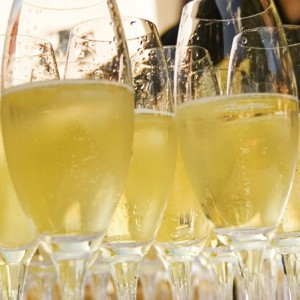We may be living in the golden age of sparkling wine. Never before has so much quality “fizz” been available to the wine consumer.
San Francisco Chronicle wine writer Jon Bonné prognosticates in his January 10 column that 2014 will be the year during which sparkling becomes as much a part of everyday drinking as a staple beverage for celebrations.
Champagne is the most famous region for bubbly, deservedly so, but it must now share the spotlight with other regions that are now carving out their spaces in the marketplace.
Here is a quick primer on sparkling wines produced outside the hallowed vineyards of Champagne. (Questions on your WSET or CSW exams will likely reference what appears below.)
Cava
Mostly produced in the Catalan region of Penedès outside Barcelona, the quality of Cava has increased dramatically in recent years.
To be called Cava, this brand of bubbly must be produced in the traditional méthode traditionnelle, i.e., the second fermentation takes place in bottle.
Cava wines are unique in that they originate from grape varieties rarely grown outside Catalonia: Macabeu (identical to Rioja’s Viura), Parellada and Xarel·lo.
Sekt
The vast majority of this German sparkler is consumed Germany. The majority of Sekt produced (around 95%) is made by the Charmat method with the remaining premium Sekt being made according to the méthode traditionnelle.
Around 90 percent of Sekt is made at least partially from imported wines from Italy, Spain and France. However, Sekt labeled as Deutscher Sekt is made exclusively from German grapes, and Sekt b.A. (bestimmter Anbaugebiete, in parallel to Qualitätswein b.A.) only from grapes from one of the 13 quality wine regions in Germany.
For Deutscher Sekt Riesling makes up the core of this style of Sekt, though Pinot Gris, Pinot Blanc and Pinot Noir play minor roles. The tragedy is that not much of this quality Deutscher Sekt is exported.
Crémant
French sparkling wines produced outside Champagne according to the méthode traditionnelle bear the name Crémant (“creamy”).
These wines are often the best values in French fizz. The Loire produces the most French Crémant, with Burgundy, Alsace and the Jura producing their fair share.
If the méthode traditionnelle is not used in the production of French bubblies outside Champagne, then the wines will bear the designation Mousseux.
Prosecco
The Italian fizz with the most sizzle in the marketplace right now is undoubtedly Prosecco, produced in Italy’s northeastern Veneto region.
According to Europe’s widely circulated the drinks business, Prosecco outperforms both Champagne and Cava in a number of the UK’s largest wine retailers, such as Tesco.
Glera (until 2009 it was referred to as Prosecco) is the name of the grape used to make Prosecco. It is produced using the Charmat method and can be found in spumante (fully sparkling) and frizzante (lightly sparkling) styles.
Franciacorta
Emerging from obscurity is Franciacorta, the Italian sparkler from Lombardy so often overshadowed by Prosecco and Asti.
Franciacorta is arguably the Italian fizz most similar to Champagne, as it must be produced according to the méthode traditionnelle. In addition, Chardonnay, Pinot Blanc and Pinot Noir are the only permitted grape varieties.
Not all Franciacorta wines sparkle, however. Only those bearing the DOCG designation will tickle the palate; those bearing DOC status are red or white still wines.
Mosacto d’Asti
The hugely popular Mosacto d’Asti originates in Piedmont, home to the great red wines of Barolo and Barbaresco.
Muscato Bianco (Muscat Blanc à Petits Grains) has been cultivated for hundreds, if not thousands, of years in the Piedmont DOCG in Italy, and is considered one of the oldest grape varieties grown in that area. Although Modern production of Moscato d’Asti as it is known now began in the 1870s.
These wines get their bubbles from the a special variation on the Charmat method. The must is chilled almost to the point of freezing to keep the fermentation process at a halt until the time is right. By law, Moscato d’Asti can only be 5.5% abv so the fermentation process is halted with a lot of the natural sugars still left in the wine. Unlike Champagne and other sparkling wines made in the méthode traditionnelle, there is no secondary fermentation allowed in the bottle, which results in softer, more delicate bubbles than Champagne.
Lambrusco
The guilty American pleasure of the 1970s and 80s, Lambrusco, from the Emilia-Romagna region of Italy’s mid-section, continues to be an Italian sparkler of note.
Like Prosecco, Lambrusco is both the name of the grape used in its production and that of the wine itself. The wine is produced using the Charmat method.
Intended to be consumed young, Lambrusco is usually medium sweet and low in alcohol.
These are just a few key facts regarding sparkling wines; to learn more we suggest taking one of our WSET or CSW courses.
Key Terms defined:
Charmat: a sparkling wine production by which the secondary fermentation takes place in pressurized stainless steel tanks. Once this second fermentation is complete, the wine is filtered and bottled under pressure. This is distinct from the méthode traditionnelle, in which secondary fermentation takes place inside the bottle. The Charmat method is known by various other names, including ‘Methode Cuve Close’, ‘Metodo Charmat-Martinotti’, ‘Metodo Italiano’, and ‘Tank Method’.
Méthode traditionnelle: the ‘traditional method’. The term has been used since 1994, when the European Union ruled that the synonymous Méthode Champenoise (Champagne method) could no longer be used unless referring to the wines of the Champagne region. Other terms that refer to the same production technique include ‘Méthode Classique’, ‘Classic Method’ and ‘Metodo Classico’. The process is defined by a secondary fermentation in-bottle, induced by adding a liqueur de tirage (a mixture of wine, sugar and yeast). The carbon dioxide produced by this secondary fermentation is trapped inside the bottle, giving the wine its bubbles. Other stages in the méthode traditionnelle include riddling or rémuage (in which the upturned bottle is regularly turned, to bring the dead yeast cells into the bottle neck) and disgorgement (in which these cells are removed). The final step before corking is dosage, in which the bottle is topped up with a mix of base wine and sugar (liqueur d’expédition).
Cheers!














